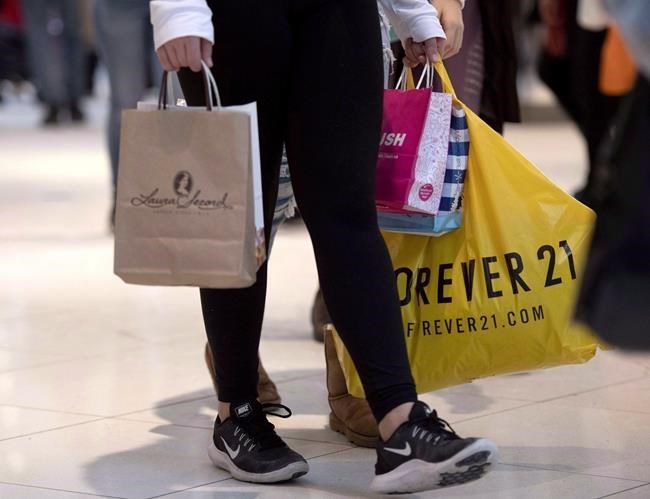TORONTO — H&M will soon test a fee for returns in Europe. Uniqlo saąúĽĘ´«Ă˝ already charges one for online returns. So does Miniso's Canadian outposts, which treat most purchases as final sale.
Shoppers, it's not your imagination. Stores are making it harder and more costly to bring back items as consumers remain hooked on a big pandemic habit: online shopping.
Retailers are tamping down because returns cost them big bucks — and every dollar counts at a time when they are recovering from the economic shutdown and coping with supply chain troubles, said Sylvia Ng, chief executive of ReturnBear, a returns collection service operating through Cadillac Fairview malls.
Ng said the pandemic left some retailers grappling with return rates around 20 or even 30 per cent of items sold.
"For their inventory and ultimately for their company to be profitable in this economic climate, I think it's very important that you look at the returns," she said. "When it's around 20 per cent of your business, you can't afford not to."
While little Canadian data exists capturing how prevalent returns have become, the country's retail trends typically follow those in the United States, said Prabhjot Gill, a McKinsey & Co. associate partner focused on retail.Â
Across the border, consumers returned US$428 billion in goods in 2020 with e-commerce responsible for at least a quarter of those returns, said a National Retail Federation and Appriss study released in January 2021.Â
A McKinsey survey and discussions with roughly 35 North American retail executives across 2019 and 2020 found 86 per cent of respondents see a lenient return policy as critical to increasing revenue and 75 per cent called returns "a necessary evil."
But there's a high incentive to reduce returns. Stores are facing expensive supply chain snags, higher materials costs and sometimes, a glut of inventory caused by slashed consumer spending amid soaring inflation.Â
H&M's higher raw material and shipping costs weighed on its most recent quarter and contributed to its share price falling to an 18-year low.
The Swedish fashion giant is simultaneously about to test return fees, though the company said in an email to The Canadian Press that the test is so far limited to Europe.Â
"But, of course, that’s only one initiative to improve the situation," Helena Helmersson, chief executive, said on a recent earnings call. "There’s many other things to do as well."
One of them could be shortening return windows, said Lisa Hutcheson, managing partner at consulting firm J.C. Williams Group.
"We used to have 30 days," she said. "There were some retailers that were 60 days and now you're seeing 14 days or 21 days."
The window is even shorter at Asian home goods company Miniso saąúĽĘ´«Ă˝.
Customers have just seven days to return online orders and must cover shipping costs and a 10 per cent restocking fee if items are returned due to "personal preferences." (In stores, Miniso's website says, "all items are final sale, except for manufacturer's defective electronics.")
Shouldering some of the blame for return window reductions is the surge in sales online, where it is hard to predict whether a product is made of quality materials or envision how something will look in your home or on your body.
McKinsey found 70 per cent of returns are caused by poor fit or style, while ReturnBear's top two return reasons are items not fitting or differing from the photo or description.
To avoid disappointment, shoppers often buy multiple sizes. There's often no financial penalty to return something that doesn't fit, since many stores offer free shipping on returns or have several locations ready to take back items.
For customers, it makes little difference how soon the item is returned as long as they are refunded, but for retailers, it's a big deal.
"These fast-fashion stores like the Zara and H&M folks, they turn their inventory very quickly, so they're in and out of something in like a couple of weeks at most," said Hutcheson.
"If something's sitting on the floor in my home because I just haven't gotten around to shipping it back, they lose that opportunity to sell something at full price."
After an item makes it back to a store or warehouse, it might be sent to clearance or even storage for next season. By then lost sale or markdown, plus shipping fees and labour, have created double the cost than if there were no return, said Gill.
Some stores want customers to reduce the burden. Uniqlo saąúĽĘ´«Ă˝'s website says apparel bought online or through click and collect can only be returned via mail and a fee of $9.90 plus tax will be applied. The company did not comment on the policy.
Zara charges a ÂŁ1.95 fee on returns made to third-party drop off points in the U.K., but also did not comment.
While Gill sees the value in reducing returns, she cautions retailers from using fees because of consumers.
"There's a lot of other retailers, often in the same space that are offering free returns, so (if you charge for returns,) they might be more likely to go with someone else."
This report by The Canadian Press was first published Nov. 3, 2022.
Tara Deschamps, The Canadian Press



